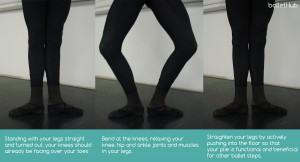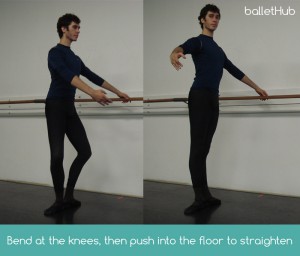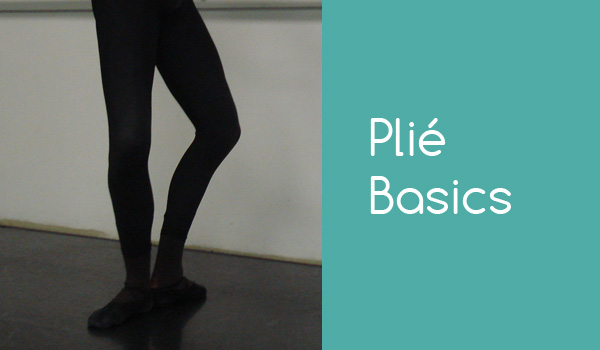Plié [plee-AY] is one of the more basic steps in ballet, but it’s arguably the most important as its often the beginning and ending of the majority of intermediate and advanced steps, provide explosive power in jumps and pirouettes and help reduce the risk of injury.
We’ll get into a more advanced look soon, but let’s start with a basic look at plié.
Basically, a plié, translating in french as “bent” or “bending”, is the action of bending at the knees. Of course, when that happens, your ankles and hips are also technically bending. There are two different types of plié: grand plié and demi plié. A grand plié is a full bend of the knees until the thighs are parallel with the floor, while a demi plié looks more like a half bend, where the heels do not come off the floor.
A plié can be done in all the 5 basic positions of the feet in classical ballet, as well as with just one leg as part of intermediate and advanced steps.
Why is Plié One of the Most Important Steps in Ballet?
Plié really is a big deal in ballet technique for a number of reasons. Think about it, how often was a plié both the start and finish of a step in the last variation you watched? Let’s look at plié a bit further and see why it’s so important in ballet:
- The start and finish of every jump starts with a plié.
- The start of most turns is from a plié and almost always ends with your standing leg in a plié.
- Plié is often a transition step, both the end of one step and the start of another.
- Doing a plié helps condition and stretch your muscles and tendons, helping to make them soft and pliable.
- A proper plié can help prevent a lot of injuries because of the spring-like motion in your legs that helps absorb impact when you land from jumps.
- A smooth plié is part of the effortless look that ballet dancers try to achieve.
The Basics of Plié in Classical Ballet
Since we’ll try to stick with just the basics with this post, here’s some things you should think about when doing a plié.
- Knees should always bend over the toes. If your knees are pointing inwards way past your big toe, you may be planting your feet on the ground and forcing your turnout and this can be very dangerous!
- Don’t stick your backside out or adjust your hips to plié.
- Your heels should not lift off the floor in a demi plié.

- The movement of a plié should always be straight down and straight up when you straighten your legs.
- Try to relax your joints as much as possible. You shouldn’t feel tension in your hips, knees or ankles.
- When you plié, you should be just as on balance as you were when you were standing with straight legs.
- Try not to grip your muscles when you plié, it should actually be quite a fluid motion.
Straightening Your Legs Out of a Plié
 Imagine your legs are springs. When you push a spring in to a table (bending your knees into a demi-plié) and then let go(straightening your legs), what happens? It quickly jumps up and away from the table because of the energy that was stored in the coil of the spring when you were pushing it down.
Imagine your legs are springs. When you push a spring in to a table (bending your knees into a demi-plié) and then let go(straightening your legs), what happens? It quickly jumps up and away from the table because of the energy that was stored in the coil of the spring when you were pushing it down.
Try thinking of the same idea when you straighten your legs from a plié. You must push straight down into the floor with your legs and feet. Don’t just casually straighten your legs.. otherwise you’re just bending and straightening your legs. And while of course that is what a plié looks like, its the intention and the purpose you put into straightening your legs that makes it functional in classical ballet and allows dancers to jump high with explosive energy and do multiple pirouettes.
Saving Your Muscles from Injury
While an injury from ballet is sometimes unavoidable, it’s always best to try to minimize the risk. One of the best ways you can do so by paying proper attention to your plié. A nice and soft plié landing from a jump can help save your knees and muscles. Imagine jumping without a plié at the end (do not try this, of course), after a short time, your whole body would suffer, not just your knees and feet, but the hard impact could eventually travel up into your back and neck.
An Advanced Look
This will be saved for another post, but there really are more advanced ways to think about plié. If you doubt that, you may want to consider this: How many times have you heard “It’s important to have a strong base…” Well, a plié is at the base of ballet technique as you can possibly get and like mentioned above, is the start and finish to a majority of intermediate and advanced steps in not just classical ballet, but practically all forms of dance.
A strong and functional plié can greatly improve your jumps, pirouettes and overall strength in all forms of dance.

